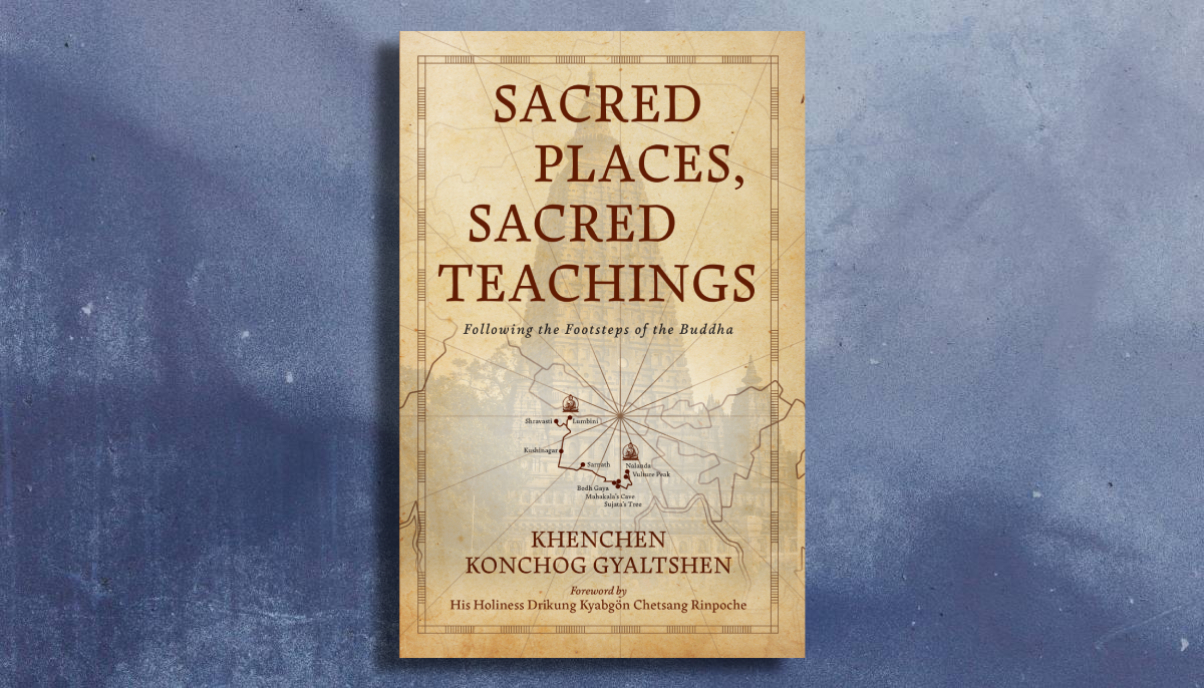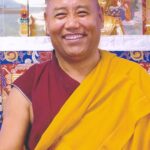Constance Kassor’s review for Buddhadharma:
For Buddhists, pilgrimage is both a journey through sacred history and a means to deepen one’s practice. By visiting holy sites, Buddhist pilgrims strengthen their connection to the Buddha’s life and teachings, encouraging greater faith and devotion.
In November 2011, Khenchen Konchog Gyaltsen led over 90 pilgrims on a two-week journey across India. His teachings at holy sites were recorded and eventually compiled into Sacred Places, Sacred Teachings: Following the Footsteps of the Buddha. This book guides readers through key pilgrimage sites, including Bodh Gaya, Vulture Peak, Sarnath, and Kushinagar. Each chapter explores one site, describing its physical features and historical significance and unpacking spiritual lessons.
For example, the chapter on Sarnath — the site of the Buddha’s first teaching — explains the fundamental doctrine of the four noble truths. And the chapter on the historic monastic university Nalanda focuses on the Bodhisattva’s Way of Life, written by the great scholar Shantideva. These teachings contextualize each location, enriching readers’ understanding of pilgrimage places and their significance.
Photographs and excerpts from texts such as Ashvaghosha’s Buddhacarita enhance the book’s vivid descriptions. This makes it valuable for those unable to visit these sites in person, while also serving as a guide for pilgrims. The book’s appendices provide additional resources, including short texts to aid in some of the practices mentioned throughout the volume, glossaries, and an annotated bibliography to aid in further study.
In his introduction, Khenchen Konchog Gyaltsen emphasizes the active nature of Buddhist practice: “We can’t leave the teachings on the table and expect peace and happiness to come without effort… our part is to take responsibility for our study and practice.” Pilgrimage is one way to take such responsibility, and Sacred Places, Sacred Teachings serves as an inspiring companion on that path.
[Please note that the text from which this excerpt derives makes use of footnotes and diacriticals; these are not represented in this excerpt.]
Excerpt:
Bodhichitta and the Buddha’s Parinirvana
After teaching for forty-five years, the Buddha showed the whole world that everyone must die—even an enlightened being. The Buddha announced to his disciples that he would die in Kushinagar and there enter parinirvana. The Buddha achieved the vajra body, absolute dharmakaya, to show us how to live our lives with wisdom and how to live in a positive way, performing good deeds, so that when we die, we die with dignity and joy, and without fear. Reflect on that. The Buddha gave these teachings more than 2,600 years ago, and they are still fresh because they are not related to culture or belief. Cultures change, but the Dharma doesn’t need to be updated. It is universal law. The mental afflictions that are experienced in samsara—ignorance, attachment, aversion, anger, greed, and so on—will never change; they will never cause peace and happiness. They are the same afflictions that people experienced in ancient times. Likewise, love, compassion, bodhichitta, serenity, and clarity of mind—the causes of happiness—will always be fresh and relevant. If you want peace and happiness, there is no choice but to follow the Dharma. There is no excuse, no negotiating, and no second option. No matter who we are, we need the Dharma teachings.
When Buddha Shakyamuni entered parinirvana in Kushinagar, he dissolved into dharmakaya, the absolute state of all buddhas. Dissolving into dharmakaya means that all obscurations have completely dissolved into emptiness; not even the subtle imprint of an obscuration is left. All concepts, including “self” and “nonself,” all the imprints of form and the afflicted skandhas, even the most subtle mental skandhas, are fully purified within the framework of dharmakaya. In that state there is absolute joy—with all the defilements purified, all that remains is wisdom, the unafflicted dharmakaya, which has the nature of total joy. The state of dharmakaya is also free from the duality of samsara and nirvana, because all duality has been completely transcended. Since its nature cannot change, it is said to be permanent. This does not mean that it is something substantial or material, but rather that the quality, the reality, of that nature never changes.
Many scholars believe that the Buddha ceased to exist following his parinirvana, and never again incarnated, but that is not the case. The Buddha still benefits sentient beings and will continue to do so as long as space remains because of his bodhichitta. Despite the conventional appearance of having entered parinirvana in front of witnesses, in reality, the Buddha’s manifestations and emanations will never cease to exist. The Buddha will continue to benefit sentient beings until the end of samsara. Many of our great teachers have personally seen visions of Buddha Shakyamuni, as well as other buddhas. For example, Gampopa had a vision of Buddha Shakyamuni teaching surrounded by a thousand buddhas. Whether we have such a profound connection to the Buddha depends on how much effort we exert. While we are learning about and reflecting on these holy places, we should remind ourselves to generate strong devotion. Visualize the Buddha and make a connection to him in your mind. This can be accomplished by developing bodhichitta. Bodhichitta is the ultimate method to unite your mind with that of the Buddha.
To cultivate bodhichitta, the cause of freedom from samsara, we first have to look at the suffering of samsara. We have already talked about the three types of suffering: the suffering of suffering, the suffering of change, and pervasive or conditioned suffering. When you look at the suffering of all sentient beings, you will be overwhelmed. You may say, “I do not want to look at that. It is too much for me.” However, reflecting on this suffering has many benefits. When we first see that all suffering—regardless of who is suffering—is based on causes, it gives us the courage to face suffering. Without a cause, no result will manifest. This understanding becomes a method for cultivating compassion and wisdom.
Contemplate this way: “I want to become free from suffering, not just from my obvious suffering now, but also from any future suffering. As I fear that maybe tomorrow I will get sick or have some other problem, I seek freedom from all suffering now. Similarly, every sentient being has the same feeling I do, whether they are sophisticated or not, whether they are more prepared or not. Everyone, even a small insect, wants to be free from suffering.” Reflect on this, and you will develop compassion. Without a good understanding of suffering, there is no basis for developing compassion. When we have a good understanding of the suffering of all sentient beings, we have a compelling reason to cultivate compassion and progress toward enlightenment.
As you can see, wisdom helps us to develop compassion, and compassion helps us to develop wisdom. We need wisdom to identify the cause of suffering. Otherwise, compassion is just emotional and limited to the few people we love. When we are sick, we try to find the best doctor to give us the best medicine and advice on how to improve our condition. Similarly, when we suffer, we should desperately look for the wisdom and solutions that will free us from that suffering. Although everyone is trying their best to free themselves from suffering, many of them make mistakes. They do not know the causes of suffering, and so they end up creating more suffering for themselves. When, based on our wisdom and understanding, we see that happening, we should develop greater compassion—not just for our own friends and relatives, but for every sentient being, regardless of who they are. By realizing how samsaric suffering is caused by afflicting emotions and negative actions, we enhance our wisdom and understanding of the law of causality, which is the nature of samsara.
On the path of practicing bodhichitta, we have to utilize all good feelings, relationships, and conditions, as well as bad feelings, relationships, and conditions. For example, when you encounter someone who is angry with you, realize that that person is indeed suffering. If he were not suffering, he would not have done anything hurtful. Someone who is compassionate and has a relaxed mind will not create problems. It is someone who is angry and upset that creates suffering, problems, and obstacles. When that happens, you just need to relax and reflect within yourself. Think about bodhichitta first, and develop compassion for that person. Then wish for that harmful person, as well as all other sentient beings, to avoid making negative karma, to be free from suffering, and to develop bodhichitta. Whether you can change that person or not, at least this will help give you a sense of serenity and peace. Unless your mind is peaceful and clear, you have no resources with which to help others. You are practicing bodhichitta and developing the strength of your own mind, so it will not be defeated by obstacles and suffering. Instead, your mind will grow full of courage, wisdom, and compassion. Having bodhichitta does not mean just being nice. Rather, it is strength and courage based on wisdom and compassion. So, utilize all the positive and negative conditions you encounter. Transform them into your path toward enlightenment. In this way, it is possible to transform samsara into nirvana and then you can connect with all the sentient beings.
The Buddha fully realized the nature of reality. He never said that he invented his philosophy of interdependent origination to achieve enlightenment. Rather, he uncovered the truth that interdependence is simply the nature of reality. Interdependent origination means that everything functions within the law of karma, and that nothing can function out- side the bounds of causes and conditions. All the Buddha’s teachings are based on the wisdom of that understanding. To see that for yourself, start by looking at the suffering of all sentient beings, then look to see whether there is any way to end that suffering. Perhaps taking a magic pill? Maybe buying a new car? Traveling to the moon or another galaxy? No, the only thing we can do is clean up ourselves. We do that by generating and cultivating our own wisdom, compassion, and bodhichitta. The solution is to achieve buddhahood; this is the absolute solution to suffering. This is why we have to cultivate bodhicitta.
Excerpted from Sacred Places, Sacred Teachings: Following the Footsteps of the Buddha by Khenchen Konchog Gyaltsen, Wisdom Publications. Used by arrangement with the Publisher. All rights reserved.

